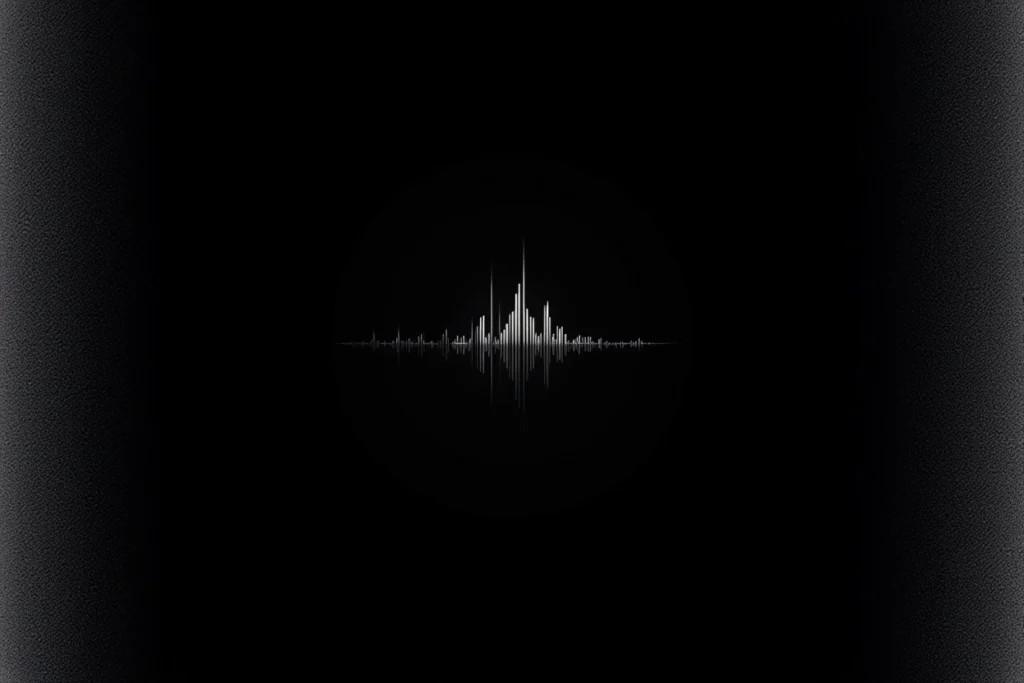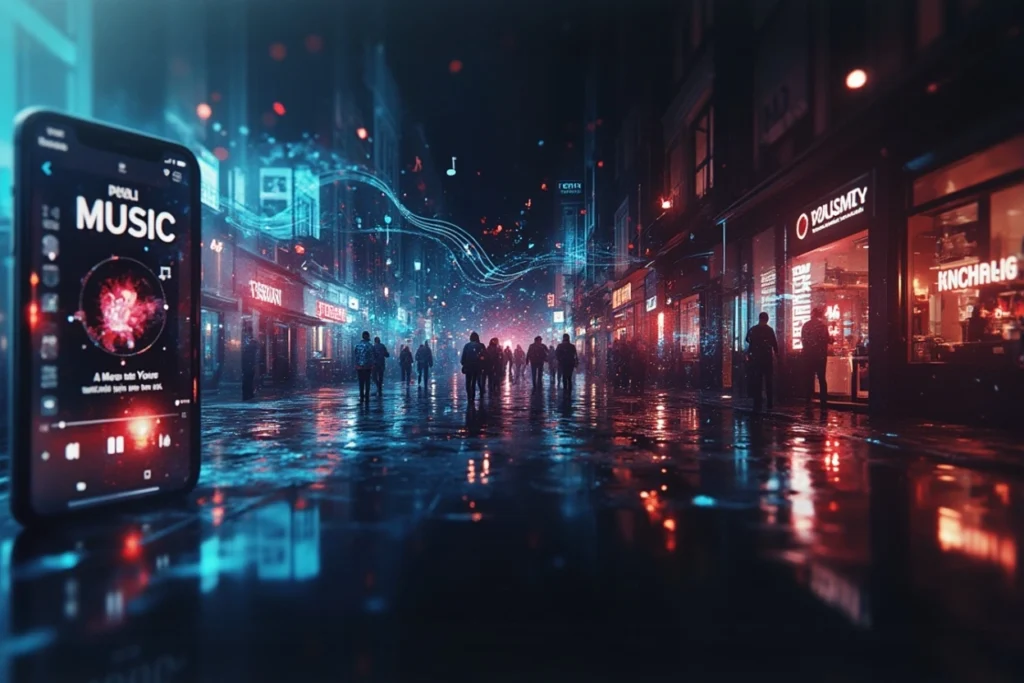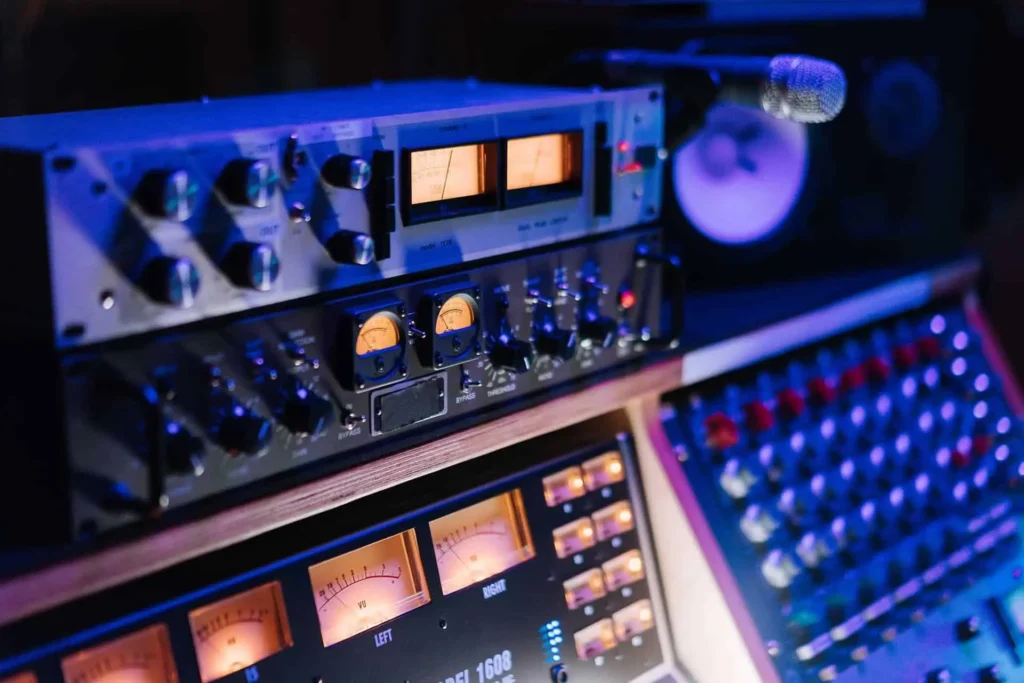What if your brand spoke… musically? Does your brand not yet speak with its own sound? It tells a bit of everything, except itself. A sound identity makes an impression, it’s not a gadget, it’s a key. It’s an auditory sesame that makes you instantly recognisable. It’s not a fad. It’s a requirement when everything is connected, when everything is experienced through the ear. The music, the jingle, the voice, the notes: these elements tell your story better than a thousand visuals.

1. What is a brand’s sound identity?
Sound identity (or musical identity) is the auditory counterpart to visual identity. It’s all the sounds, voices, music and atmosphere that echo your brand. It goes beyond the simple jingle: it’s a global sound charter.
Here are a few characteristics:
- Brief and memorable (just a few seconds are enough)
- Conveys your values, your story, your personality (premium, fun, technological, etc.).
- Consistent across all points of contact (ad, app, shop, terminal, interface).
- Promotes immediate recognition.
The musical identity is a subset: it corresponds more specifically to the dominant theme or melody.
2. Why brands absolutely need a signature sound
You might think that creating music is a bit “decorative”, that your consumers are insensitive to it. You’d be wrong. Sound is strategically more powerful than many visual elements.
Stand out from the crowd
We’re immersed in the visual. Logos, visuals, animations, it’s all saturated. But sound is less saturated. A good sound territory stands out and is noticeable. It’s not for nothing that many sound identities have won awards over the last few years (prix stratégies design, grands prix de la communication, etc.).
Enhancing memorability
Music activates deep areas of the brain: memory, emotion, recollection. The creation of a well-crafted sound signature creates a lasting impression.
To link emotion to message
Unlike images, sound is intrinsically emotional. A minor chord, voices, resonances – all convey the mood of the brand. This is the essence of sensorial marketing applied to the auditory domain.
Being everywhere, even without a visual
Audio interfaces, voice assistants, podcasts, in-vehicle systems, telephone reception… In “screen-free” environments, a company’s sound identity plays a key role.
For brand credibility and consistency
A brand that neglects sound in its audio communication leaves a blind spot. Your competitors who have a sound charter already speak a language that you don’t use.
3. The components of a sound identity (and how to think about them)
Building a sonic identity is not the same as throwing tracks into a software programme. It’s brand design. Here are the essential building blocks:
The sound logo
Also known as the audio logo, jingle or musical signature, this is the heart. In 2 to 5 seconds, this little melodic motif should be enough to recognise the brand or brand name. It functions as the auditory counterpart to the visual logo.
It supports advertising or storytelling formats. It can be varied in different formats: short version, long version, remix depending on the context.
Brand music or sound DNA
This is sometimes called “sound identity”. This is a longer composition from which the sound signature is derived; it is the musical embodiment of your brand, your sound territory. It can be adapted to suit different contexts: corporate films, motion design, podcasts, etc.
Variations
All points of contact are scrutinised: digital videos, social networks, events, telephone on-hold. Music reinforces your brand awareness at 360°.
Ambience and environmental sounds
When you enter a shop, you hear ambient sounds, layers of music and light sound effects. These sounds contribute to the immersive experience and reinforce the brand image.
The brand voice
When the brand speaks: voicemails, announcements, voice assistants, the voice is a sound component in its own right. It must be aligned. Accent, timbre, rhythm, intonation, all these elements become markers.
The sound charter
This is the document that describes the rules of use: tonality, tempo, instrumentation, variations. It provides a framework for consistent use of the sound identity across all media.

4. Creative methodology: from strategy to sound
Here are the steps to building a high-performance audio identity:
Diagnosis & positioning
We define your world, your values, your promise. We identify the points of contact: advertising, digital, in-store, interfaces.
Sound research and benchmarking
We explore what our competitors and neighbouring industries are doing. We determine what to avoid so as not to sound like everyone else. Because to do what everyone else is doing is to disappear!
Composition and prototyping
Workshops with composers, sound designers and musicians. We create notes, melodies, sound patterns, in test.
Tests and iterations
Your targets test the versions. We gather feedback, memorability, emotion. We adjust the voices, instruments and tempi.
Finalisation & deliverables
We formalise the sound logo, musical signature, atmospheres and sound charter. We deliver high-quality, multi-format files for all uses.
Deployment and activation
We insert the sound logo into your videos, adverts, apps, points of sale and events. We train your marketing/communications teams in its consistent use.

5. Common mistakes to avoid
- Taking generic music from a bank: you lose all originality.
- Using a “low cost” version: consistency suffers.
- Neglecting variations (advertising, point of sale, interfaces).
- Ignore intellectual property: music should be protected like a brand.
- Not testing with your audience: the creator’s ear is no substitute for user feedback.

7. How can this creation be promoted internally and externally?
This is where the work of evangelisation begins:
Internally
- Educate the teams (marketing, communications, digital) in the use of the sound logo.
- Create a simple, visual sound charter (e.g. “short jingle / long jingle / atmosphere” pictograms).
- Encourage internal audio recordings (podcasts, internal messages) to carry your signature.
Externally
- Communicate your new sound identity as a strong sign of modernity to your customers.
- Have your logo heard, for example in teaser videos.
- Include the signature in commercials, radio ads and videos.
- Highlight reception studies: “X% of people recognised it after 3 listens”.
8. Gaining ROI with audio branding
Brand audio identity is not an expense, it’s a lever:
- Increases brand recall and spontaneous recall;
- Increases brand loyalty;
- Improves the effectiveness of audio messages (radio ads, commercials, podcasts);
- Creates an intangible asset: a unique, protected sound that belongs to you.
When you invest in audio identity creation, you’re buying sustainability.

9. In short: make your brand resonate
Your brand deserves a unique voice. Not borrowed music, not a clichéd jingle. A strong, rigorous, differentiating concept. A sound identity designed to align you, set you apart and make you recognisable.
What’s next?
If you’ve made it this far, it’s probably because you sense how sound can transform your brand. That’s where Brandy Sound comes in.
Brandy Sound is a music design and sound identity agency based in Paris. We help brands stand out through unique, strategic and emotionally powerful sound creations.
Our team designs :
– audio logos (audio jingles)
– brand musical territories
– coherent sound charts for all your points of contact
– tailor-made music production
– brand voices and corporate podcasts
Want to create or rethink your sound identity?
Let your difference be heard. Let your brand resonate!
Get in touch with us!
Things to remember
-
Sound identity is strategic, not incidental: it enables your brand to be instantly recognised in a world saturated with visual messages. It’s a powerful tool for memorising, differentiation and emotion.
-
It is based on key components: logo sound, jingle, brand voice, atmosphere… all of which must be consistent and aligned with your values. The whole package is framed by a rigorous sound charter to guarantee unity at all points of contact.
-
Its creation follows a structured approach: diagnosis, benchmark, composition, tests, deliverables and activation. An effective sound identity cannot be improvised; it must be designed methodically to maximise its impact and ROI.
